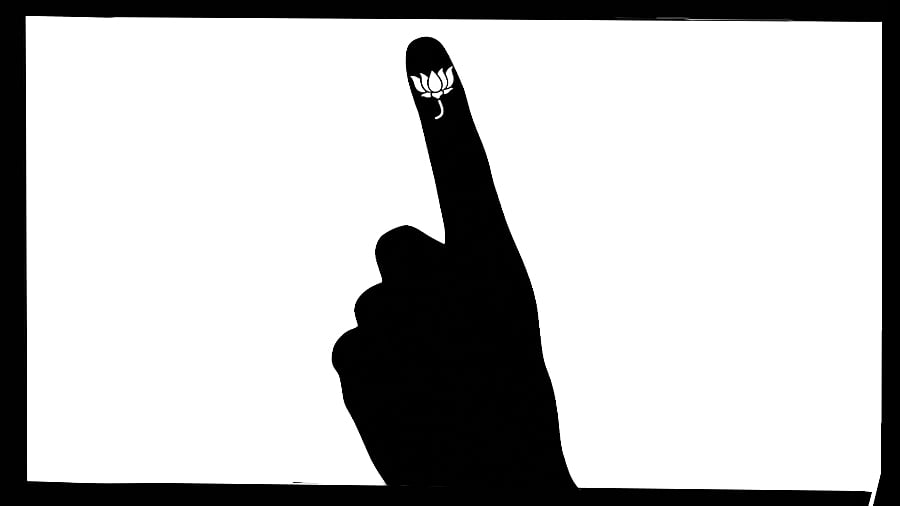
Credit: DH illustration
At the core of the BJP’s dual identity lies a profound contradiction: its ideological commitment to Hindutva and its simultaneous attempt to court non-Hindu and lower-caste voters. Hindutva, rooted in the idea of seeing India only as a Hindu nation, has historically marginalised religious minorities, lower castes while observing women as mothers and child-bearers in derogating, patriarchal ways. Yet under Narendra Modi, the BJP has made significant inroads, in some cases with assistance from the RSS (and its grassroots-level outreach in Hindi-heartland states), and retained key bases among these groups in the 2024 Lok Sabha election.
Similarly, its attempts to appeal to Muslim women by advocating for the abolition of triple talaq coexist uneasily with anti-minority rhetoric and policies such as the Citizenship Amendment Act (CAA) and the revocation of Article 370 in Jammu and Kashmir. These contradictions are not merely rhetorical – they also reflect deeper tensions in the BJP’s governance model that threaten to undermine India’s secular and social fabric. This adopted duality for electoral survival and power also challenges the BJP’s transactional, populist narrative of ‘empowerment’ which merely repackages entitlement-based short-term welfare transfers as ‘opportunities for higher mobility’ without making substantive investments in human capital development, employment generation, and economic security for lower, middle, and lesser privileged classes.
This makes one also inquire: Does BJP’s electoral support among Dalits and OBCs represent genuine inclusion, or is it merely transactional welfare politics? Welfare schemes, often designed to create direct links between beneficiaries and the central government, serve as powerful tools for voter mobilisation. BJP’s appeal to marginalised groups, however, often stops short of structural reforms that would address entrenched inequalities.
The party’s rise as a pan-Indian political force is marked by its ability to adapt and dominate across diverse regional landscapes, leveraging socio-economic narratives and targeted outreach to secure its position. From the Hindi heartland of the North to the politically resistant South of India, the BJP’s strategies have systematically reshaped India’s electoral map – these extend to its efforts in the eastern and western parts of the country. The methods employed to achieve this dominance, however, also raise critical questions about the implications for federalism and India’s pluralistic fabric.
In the North, the BJP cemented its dominance by dismantling caste-based regional alliances. A case in point is Phulpur, a constituency in Uttar Pradesh that was once a symbol of Congress-era politics. Its strategic
engagement in the state has been redefining caste dynamics, securing a loyal voter base. In Bihar, alliances with the Janata Dal (United) and hyper-local caste recalibrations have delivered victories in constituencies such as Gopalganj, breaking the Rashtriya Janata Dal’s long-standing grip.
In the East, the BJP’s rise in West Bengal highlights its ability to disrupt entrenched regional parties. Similarly, in Odisha, victories in constituencies like Dhamnagar underscore how welfare schemes and infrastructure commitments resonate with economically vulnerable voters.
In the South, the BJP faces more resistance but has made calculated inroads. Karnataka remains its stronghold, with constituencies like Bengaluru South showcasing its urban appeal. In Telangana, the party won eight of the 17 Lok Sabha constituencies in 2024. In Tamil Nadu, where Dravidian politics dominates, the BJP’s focus has been on Tamil pride and heritage, reflecting a slow but deliberate strategy to establish itself.
In the West, the BJP has leveraged its partnership with the RSS to deepen grassroots connections, as reflected in Maharashtra, where over 60,000 RSS-facilitated meetings were held ahead of the recent Assembly election.
Despite these successes, critics argue that the BJP’s strategies come at a significant cost. Its welfare outreach, while fostering development, is often selective, undermining the structural reforms needed for long-term change.
Furthermore, its use of divisive narratives – blending welfare promises with Hindutva and centralising power – threatens India’s pluralistic ethos and federal structure. The BJP’s dominance may secure electoral victories, but the broader societal consequences of these techniques pose serious challenges to the democratic integrity and inclusivity of India’s political landscape.
Politics of welfare populism
Central to the BJP’s electoral strategy is its extensive use of welfare politics. Flagship schemes such as the Ayushman Bharat, which provides health insurance to over 500 million people, and PM-KISAN, offering income support to farmers have been instrumental in consolidating temporal support amongst the larger percentage voting groups: from rural and economically disadvantaged voters.
During the Covid-19 pandemic, initiatives like the Pradhan Mantri Garib Kalyan Yojana, which provided free food grains to millions of families, further solidified the BJP’s pro-poor image. These efforts have transformed voter perceptions, creating a direct connection between welfare benefits and Modi’s leadership. This limited welfare-driven approach also exposes stark contradictions.
Modi’s frequent criticism of revdi (freebie) culture rings hollowrings hollow considering the approximately Rs 34 lakh crore spent on welfare schemes. It could be argued that this persistent reliance on welfare politics highlights the party’s electoral pragmatism rather than a commitment to sustainable governance.
By prioritising short-term gains over long-term development, the BJP risks perpetuating dependency rather than fostering empowerment. Moreover, the selective application of welfare programmes raises concerns about politicisation. Data suggests that welfare schemes are often concentrated in BJP-dominated regions, reinforcing electoral strongholds rather than addressing nationwide inequities.
This approach undermines the principle of equitable governance, creating a perception that welfare is not a universal right but a political reward. Such strategies, while electorally effective, erode the integrity of democratic governance, reducing citizens to beneficiaries rather than empowered stakeholders.
The BJP’s dominance has profound implications for Indian democracy. The complex blend of projected inclusivism in electoral campaigns while continuing communally charged polarisation to secure ideological objectives for the BJP raises critical questions about the evolving nature of India’s democratic republic which, at this time, seems indifferently ignorant of the basic constitutional charter and its application.
(The writer is a professor, dean, and director, Centre for New Economic
Studies, O P Jindal Global University; Ankur Singh contributed to this article)